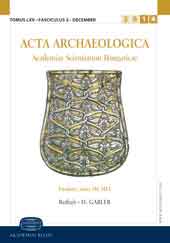Eberhauerschmuck und Schweinekiefer-Beigaben in den Neolithischen und Kupferzeitlichen Bestattungssitten des Karpatenbeckens
Polished and perforated pendants carved from boar tusks, and jaws of boars and pigs are frequent grave
furniture in the Late Neolithic and Early Copper Age cemeteries of the Carpathian Basin
Author(s): István Zalai-Gaál, Erika Gál, Kitti Köhler, Anett OsztásSubject(s): Archaeology, Customs / Folklore, Visual Arts, Ethnohistory, Ancient World
Published by: Akadémiai Kiadó
Keywords: boar tusk pendants; boar/pig jaw grave furniture; Lengyel culture; Alsónyék-Kanizsa-dűlő; late Neolithic and early Copper Age typology and chronology; social status;
Summary/Abstract: Polished and perforated pendants carved from boar tusks, and jaws of boars and pigs are frequent grave furniture in the Late Neolithic and Early Copper Age cemeteries of the Carpathian Basin. Pairs of tusk pendants were generally placed beside the dead in the early phase of the Lengyel culture, especially beside high status males, who wore these objects as symbols. The 2500 graves of the Alsónyék-Kanizsa-dűlő cemetery represent the late phase of the Lengyel culture, where instead of the pairs of tusk pendants, a huge boar tusk or a tusk disc perforated at the wider terminal was placed on the skull or beside the skull. Pig jaw grave furniture is missing here. The authors examine the occurrence of these types of grave finds in the Neolithic of the Carpathian Basin and Central and South-Eastern Europe. They try to classify the finds and determine their chronology and function.
Journal: Acta Archaeologica Academiae Scientiarum Hungaricae
- Issue Year: 60/2009
- Issue No: 2
- Page Range: 303-355
- Page Count: 53
- Language: German
- Content File-PDF

